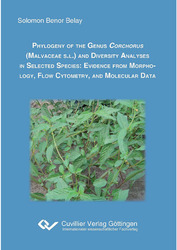| Fachbereiche | |
|---|---|
| Buchreihen (96) |
1366
|
| Nachhaltigkeit |
3
|
| Gesundheitswesen |
1
|
| Geisteswissenschaften |
2355
|
| Naturwissenschaften |
5398
|
| Mathematik | 229 |
| Informatik | 319 |
| Physik | 979 |
| Chemie | 1362 |
| Geowissenschaften | 131 |
| Humanmedizin | 243 |
| Zahn-, Mund- und Kieferheilkunde | 10 |
| Veterinärmedizin | 102 |
| Pharmazie | 147 |
| Biologie | 835 |
| Biochemie, Molekularbiologie, Gentechnologie | 121 |
| Biophysik | 25 |
| Ernährungs- und Haushaltswissenschaften | 45 |
| Land- und Agrarwissenschaften | 1004 |
| Forstwissenschaften | 201 |
| Gartenbauwissenschaft | 20 |
| Umweltforschung, Ökologie und Landespflege | 148 |
| Ingenieurwissenschaften |
1785
|
| Allgemein |
97
|
|
Leitlinien Unfallchirurgie
5. Auflage bestellen |
|
Erweiterte Suche
Phylogeny of the genus corchorus (Malvacea S.L.) and diversity analyses in selected species
Evidence from morphology, flow cytometry, and molecular data
Solomon Benor Belay (Autor)Vorschau
Inhaltsverzeichnis, Datei (43 KB)
Leseprobe, Datei (710 KB)
Corchorus (Malvaceae s.l.), investigated for the first time using nuclear rDNA ITS
sequences, and addresses diversity of selected species, which were conducted
using morphological, molecular, and flow cytometry methods.
Prior to this study, little information was available regarding the biodiversity and
potential use of jute (Corchorus species) in Ethiopian agriculture. The present study
summarizes species’ ecological distribution, use, and ethnobotany of Corchorus
species in Ethiopia. About 13 species were recorded, ranking the country second in
the total number of species in Africa. The study revealed low similarity in species
composition between the regional states, indicating that each region has its own
unique set of species. Farmers’ perception, indigenous knowledge and folk taxonomy
of jute species are more comprehensive in the southwest than other studied regions
of the country. Although several jute species are found in Ethiopia, they are neither
cultivated nor popularly used as leafy vegetables. This part of the dissertation
emphasizes the need for creating of public awareness of jute in Ethiopian agriculture
and recommends conservation measures for some threatened species.
In addition to the species collected from Ethiopia, I included several other jute
species in order to infer the phylogenetic relationships within the genus Corchorus. A
molecular phylogenetic analysis was conducted using sequences of the nuclear
ribosomal DNA internal transcribed spacer region (ITS) for 144 accessions
representing about 48 species from entire pantropical distribution of the genus. In all
phylogenetic analyses (maximum likelihood, Bayesian approaches, maximum
parsimony), Corchorus is monophyletic when Pseudocorchorus is included. The
majority of African Corchorus species formed a statistically highly supported and
distinct clade separated from the rest of pantropically-distributed species. Species
from Australia, New Caledonia and tropical America were nested within the African
clade, indicating dispersals to the rest of pantropics out of Africa. Based on the taxa
included in this study, the two cultivated species (C. olitorius and C. capsularis)
shared a common ancestry with wild species of C. africanus, C. brevicornatus, C.
pseudocapsularis, C. pseudo-olitorius, C. urticifolius, C. pilosus, C. orinocensis, and
C. cunninghamii.
The phylogenetic study indicated for the first time that Pseudocorchorus
species were found to be members of Corchorus and shared a common ancestry
especially with C. siliquosus, a species endemic to tropical America, and C.
depressus, which is common to Africa and Asia. The monophyly of
Corchorus/Pseudocorchorus seems, therefore, in accord with the overall very high
morphological and anatomical similarities between both taxa. Thus, inclusion of the
six Pseudocorchorus species into Corchorus might be appropriate. Nevertheless, I
do not suggest a new formal classification of Corchorus/Pseudocorchorus, as
additional molecular markers should be used to clarify the phylogenetic position of
the taxa before taxonomic changes are made.
Flow cytometric investigation of genome size variation in C. olitorius resulted in
a 2C nuclear DNA content from 0.882 ± 0.004 pg to 0.942 ± 0.004 pg, with a mean of
0.918 ± 0.011 pg. The mean genome size variation in C. olitorius accessions from
Africa was higher than in Asia. Genome size was positively correlated to seed
surface area and growing elevation, and negatively to days to flowering. The
estimated genome size of C. olitorius (449 Mbp) and C. capsularis (392 Mbp) is
smaller than that of many of the cultivated crops and is closer to rice, indicating a
general advantage for any efforts into genomics or sequencing approaches of these
species.
For Corchorus olitorius, genetic diversity and relationships in worldwide
collections was also investigated based on molecular (AFLP) and morphological
methods. Both methods showed similar results. High level of morphological variation,
gene diversity, percent polymorphism, and number of private fragments were
detected in African populations, and the neighbor-joining analysis in the AFLP study
showed Asian materials to be nested within the African accessions, supporting that
Africa is the center of origin for C. olitorius. The high genetic relationship of Asian
materials with those from North and East Africa might therefore indicate a possible
route for the dispersal and spread of C. olitorius out of Africa into Asia.
| ISBN-13 (Printausgabe) | 3869559241 |
| ISBN-13 (Printausgabe) | 9783869559247 |
| ISBN-13 (E-Book) | 9783736939240 |
| Sprache | Englisch |
| Seitenanzahl | 138 |
| Umschlagkaschierung | glänzend |
| Auflage | 1 Aufl. |
| Band | 0 |
| Erscheinungsort | Göttingen |
| Promotionsort | Kassel |
| Erscheinungsdatum | 02.11.2011 |
| Allgemeine Einordnung | Dissertation |
| Fachbereiche |
Biologie
Land- und Agrarwissenschaften |
| Schlagwörter | Corchorus, Corchorus olitorius, Corchorus capsularis, ethnobotany, genome size, jute, Malvaceae s.l., molecular systematics, nuclear DNA content, phylogeny, Pseudocorchorus |








